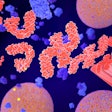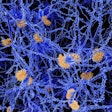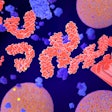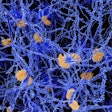
Blood-based biomarker testing for Alzheimer's disease performed well in two prospective studies for assessing beta-amyloid plaque buildup in the brain. The test has potential for saving money on positron emission tomography (PET) scans and spinal taps, as well as for broadening access to diagnosis, researchers reported on June 24 in JAMA Neurology.
The accuracy of Elecsys automated assays (Roche Diagnostics) for measuring the ratio of beta-amyloid peptides 42 and 40 (Aβ42/Aβ40) was bolstered by testing for the APOE genotype, which is associated with poor prognosis in Alzheimer's disease (AD), in the two studies of a total of 1,079 patients.
The accumulation of plaque in the brain, which is evident long before the development of cognitive symptoms, is used to determine eligibility in trials of drugs targeting beta amyloid. Deploying blood testing for screening in these studies could reduce PET costs by 30% to 50%, reported a team led by Dr. Sebastian Palmqvist, PhD, a neurologist at Skåne University Hospital in Malmö, Sweden.
"Potential future applications of these blood tests include prescreening of [beta-amyloid] positivity in clinical AD trials to lower the costs and number of positron emission tomography scans or lumbar puncture," the authors wrote.
Boosting access to diagnosis
Blood tests are being developed as a noninvasive, more cost-effective alternative to PET and cerebrospinal fluid (CSF) measurements for detecting and measuring the buildup of plaques in the brain. The authors noted that about one in 10 people ages 65 and older have Alzheimer's disease and more than 100 million will have it by 2050.
As the number of failures to develop new drugs for the disease increases, efforts in drug development are moving to earlier and earlier stages of the disease and more toward a prevention model. But this requires much larger studies that would be greatly eased by the availability of noninvasive testing methods.
"The costs and limited access to PET or CSF analysis may restrict their use to a minority of cases," Palmqvist et al wrote. "There is thus a great need for readily available methods that can detect brain [beta amyloid], and perhaps the most desirable goal has been to establish blood-based biomarkers."
Plasma testing has proved to be accurate with immunoprecipitation/mass spectrometry assays, but these are expensive and much work remains for them to be used in primary care and/or large screening settings, Palmqvist and colleagues noted.
The Swedish researchers used the Elecsys assays on Roche's cobas e 601 analyzer to test the Aβ42/Aβ40 ratio in blood and CSF in the Biomarkers for Identifying Neurodegenerative Disorders Early and Reliably (BioFINDER) study of 842 people with no cognitive impairment, mild impairment, or Alzheimer's dementia. The researchers also assessed other markers -- plasma tau, APOE genotyping, and neurofilament light (NfL) chain -- and then followed up with testing in a validation cohort of 237 people. In addition, they performed a cost-effectiveness analysis.
In the BioFINDER study, 368 of the 842 participants were positive for beta amyloid, including 147 of 517 who had no cognitive impairment and 157 of 265 with mild cognitive impairment. Palmqvist and colleagues reported a statistically significant correlation between all plasma and CSF biomarkers. The area under the receiver operating characteristic curve (AUC) for Aβ42/Aβ40 in predicting beta-amyloid status was 0.77; when considered as separate biomarkers, the AUC was 0.80.
Adding plasma tau to Aβ42 and Aβ40 delivered a nonsignificantly higher AUC of 0.81, and adding APOE to Aβ42 and Aβ40 brought the AUC to 0.85, a significant increase. Adding plasma tau to Aβ42, Aβ40, and APOE brought the AUC to 0.86.
In the second study, the validation cohort of 237 participations, the AUC for Aβ42/Aβ40 in predicting beta-amyloid status was 0.86. Results for APOE were not available.
Furthermore, the cost-benefit analysis showed that for 1,000 beta-amyloid positive people where the screening cost for PET was $4,000, using a blood test for Aβ42, Aβ40, and APOE would reduce the number of PET scans by about 800, lowering costs from $9.2 million to $6 million.
| Trial result highlights: Elecsys blood tests for predicting amyloid plaque | ||
| Plasma biomarker | Sensitivity (95% CI) | Specificity (95% CI) |
| BioFINDER cohort (n = 842) | ||
| Aβ42/Aβ40 ratio | 75% (68%-80%) | 72% (65%-77%) |
| Aβ42, Aβ40 (separate biomarkers) | 73% (65%-78%) | 76% (68%-80%) |
| Aβ42, Aβ40, tau | 86% (78%-90%) | 68% (61%-72%) |
| Aβ42, Aβ40, NfL | 84% (76%-88%) | 70% (62%-74%) |
| Aβ42, Aβ40, APOE | 88% (82%-92%) | 68% (58%-72%) |
| Aβ42, Aβ40, tau, NfL, APOE | 73% (64%-78%) | 86% (77%-89%) |
| Validation cohort (n = 237) | ||
| Aβ42/Aβ40 ratio | 70% (61%-80%) | 73% (61%-81%) |
| Aβ42, Aβ40 (separate biomarkers) | 89% (80%-95%) | 69% (54%-81%) |
| Aβ42, Aβ40, tau | 89% (74%-94%) | 64% (49%-74%) |
Putting blood testing to use
The latest data add to recent studies showing that beta-amyloid markers in blood correlate with brain beta amyloid and can help differentiate between people with Alzheimer's and healthy individuals. Testing blood for the beta-amyloid markers with the APOE genotype has potential for use as a noninvasive prescreening test in primary care, along with other assessments, as well as for use in clinical Alzheimer's trials, the authors concluded.
Practically speaking, fully automated Elecsys assays have a leg up, as they have already been implemented in many clinical laboratories that provide analyses for primary care, they noted.
"Although further validation studies are needed, this illustrates the potential usefulness blood assays might have, especially considering the ongoing great need to recruit large cohorts for AD drug trials in preclinical and prodromal stages," Palmqvist et al wrote.
"Overall, the performance of the assay was excellent," and the preliminary data reported suggest a role for using blood tests to screen for amyloid positivity and mark several significant advances in the field, wrote Sid O'Bryant, PhD, a professor of pharmacology and neuroscience at the University of North Texas (UNT) Health Science Center, in an accompanying editorial in JAMA Neurology.
"The goal of such a test, as with all primary care screening tests, is to have a very high negative predictive power to rule out the large numbers of patients who do not need additional procedures and can be told 'you're okay, stop worrying,' " O'Bryant wrote.
O'Bryant also noted that the fully automated procedure "yields performance measurements that are superior to many earlier nonautomated procedures."
Scalability, however, is still a concern, as it is generally for Alzheimer's disease biomarkers when moving from the clinic to practice. "The blood collection and processing procedures are not applicable to standard clinical lab practice and will cause substantial barriers to clinical application," he wrote.
"If primary care physicians are to use such a technology, the technology must have the capacity to conduct hundreds of millions of assays annually around the globe," O'Bryant wrote.
Another caveat is that the study design is more applicable for drug trials than clinical practice, as there still is no beta-amyloid targeting drug available for use in cases of positive test results.
However, O'Bryant ended on an upbeat note, concluding that the "field is rapidly moving from 'if' blood biomarkers can be used in AD to 'how' they can be used."
"This work demonstrates the superiority of automated technologies, and the findings provide a solid foundation on which to build," he concluded.



















